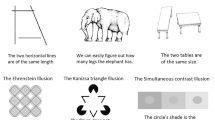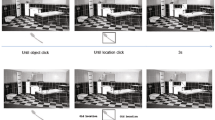Abstract
Iconic memory is the ability to accurately recall a number of items after a very brief visual exposure. Previous research has examined these capabilities in typically developing (TD) children and individuals with intellectual disabilities (ID); however, there is limited research on these abilities in children with Autism Spectrum Disorders (ASD). Twenty-one TD and eighteen ASD children were presented with circular visual arrays of letters for 100 ms and were asked to recall as many letters as possible or a single letter that was cued for recall. Groups did not differ in the number of items recalled, the rate of information decay, or speed of information processing. These findings suggest that iconic memory is an intact skill for children with ASD, a result that has implications for subsequent information processing.


Similar content being viewed by others
References
American Psychiatric Association. (2000). Diagnostic and statistical manual of mental disorders (4th ed.). Text revision. Washington, DC: Author.
Atkinson, R. C., & Shiffrin, R. M. (1971). The control of short-term memory. Scientific American, 225, 82–90.
Auyeung, B., Baron-Cohen, S., Wheelwright, S., & Allison, C. (2007). The autism spectrum quotient: Children’s version (AQ-Child). Journal of Autism and Developmental Disorders, 38, 1230–1240.
Baron-Cohen, S., Hoekstra, R., Knickmeyer, R. A., & Wheelwright, S. (2006). The autism spectrum quotient (AQ)—Adolescent version. Journal of Autism and Developmental Disorders, 36, 343–350.
Baumeister, A. A., Runcie, D., & Gardepe, J. (1984). Processing information in iconic memory: Differences between nonretarded and retarded subjects. Journal of Abnormal Psychology, 93, 433–447.
Bebko, J. M., & Luhaorg, H. (1998). The development of strategy use and metacognitive processing in mental retardation: Some sources of difficulty. In J. A. Burack, R. M. Hodapp, & E. Zigler (Eds.), Handbook of mental retardation and development (pp. 382–407). Cambridge: Cambridge University Press.
Bebko, J. M., & Ricciuti, C. (2000). Executive functioning and memory strategy use in children with autism. Autism, 4, 299–320.
Bennetto, L., Pennington, B. F., & Rogers, S. J. (1996). Intact and impaired memory function in autism. Child Development, 67, 1816–1835.
Chan, A. S., Cheung, M., Han, Y. M. Y., Sze, S. L., Leung, W. W., Man, H. S., et al. (2009). Executive function deficits and neural discordance in children with Autism Spectrum Disorders. Clinical Neurophysiology, 120, 1107–1115.
Denckla, M., & Rudel, R. (1976). Rapid ‘automatized’ naming (R.A.N.): Dyslexia differentiated from other learning disabilities. Neuropsychologia, 14, 471–479.
Dick, A. O. (1969). Relation between the sensory register and short-term storage in tachistoscopic recognition. Journal of Experimental Psychology, 82, 250–263.
Graziano, M., & Sigman, M. (2008). The dynamic of sensory buffers: Geometric, spatial, and experience-dependent shaping of iconic memory. Journal of Vision, 8, 1–13.
Haith, M. M., Morrison, F. J., Sheingold, K., & Mindes, P. (1970). Short-term memory for visual information in children and adults. Journal of Experimental Child Psychology, 9, 454–469.
Hermelin, B., & O’Connor, N. (1967). Remembering of words by psychotic and subnormal children. British Journal of Psychology, 53, 213–218.
Hill, E. L. (2004). Executive dysfunction in autism. Trends in Cognitive Sciences, 8, 26–32.
Krug, D. A., & Arick, J. R. (2003). Krug Asperger’s disorder index. Austin, TX: Pro-Ed Inc.
Lord, C., Rutter, M., DiLavore, P. C., & Risi, S. (2002). Autism diagnostic observation schedule: ADOS. Los Angeles, CA: Western Psychological Services.
Miller, R., Rammsayer, T. H., Schweizer, K., & Troche, S. J. (2010). Decay of iconic memory traces is related to psychometric intelligence: A fixed-links modeling approach. Learning and Individual Differences, 20(6), 699–704.
Minshew, N. J., Goldstein, G., & Siegel, D. J. (1997). Neuropsychologic functioning in autism: Profile of a complex information processing disorder. Journal of the International Neuropsychological Society, 3(4), 303–316.
Mosley, J. L. (1978). The tachistoscopic recognition of letters under whole and partial report procedures as related to intelligence. British Journal of Psychology, 69, 101–110.
Mottron, L., Burack, J. A., Stauder, J. E. A., & Robaey, P. (1999). Perceptual processing among high-functioning persons with autism. Journal of Child Psychology and Psychiatry, 40(2), 203–211.
O’Riordan, M. A. (2004). Superior visual search in adults with autism. Autism, 8(3), 229–248.
O’Riordan, M., & Plaisted, K. (2001). Enhanced discrimination in autism. The Quarterly Journal of Experimental Psychology A: Human Experimental Psychology, 54(4), 961–979.
O’Riordan, M. A., Plaisted, K. C., Driver, J., & Baron-Cohen, S. (2001). Superior visual search in autism. Journal of Experimental Psychology: Human Perception and Performance, 27(3), 719–730.
Ozonoff, S., & Strayer, D. L. (2001). Further evidence of intact working memory in autism. Journal of Autism and Developmental Disorders, 31, 257–263.
Plaisted, K. C., O’Riordan, M., & Baron-Cohen, S. (1998). Enhanced discrimination of novel, highly similar stimuli by adults with autism during a perceptual learning task. Journal of Child Psychology and Psychiatry, 39(5), 765–775.
Roid, G. H. (2003). Stanford Binet intelligence scales (5th ed.). Itasca, IL: Riverside Publishing.
Rutter, M., LeCouteur, A., & Lord, C. (2003). Autism diagnostic interview-revised. Los Angeles: Western Psychological Services.
Saccuzzo, D. P., Kerr, M., Marcus, A., & Brown, R. (1979). Input capability and speed of processing in mental retardation. Journal of Abnormal Psychology, 88, 341–345.
Scheuffgen, K., Happé, F., Anderson, M., & Frith, U. (2000). High “intelligence,” low “IQ”? Speed of processing and measured IQ in children with autism. Development and Psychopathology, 12, 83–90.
Sheingold, K. (1973). Developmental differences in intake and storage of visual information. Journal of Experimental Child Psychology, 16, 1–11.
Sperling, G. (1960). The visual information available in brief visual presentations. Psychological Monographs: General and Applied, 74, 1–29.
Wallace, G. L., Anderson, M., & Happé, F. (2009). Brief report: Information processing speed is intact in autism but not correlated with measured intelligence. Journal of Autism and Developmental Disorders, 39, 809–814.
Wechsler, D. (1999). Wechsler abbreviated scale of intelligence. New York, NY: The Psychological Corporation: Harcourt Brace & Company.
Williams, D. L., Goldstein, G., Carpenter, P. A., & Minshew, N. J. (2005). Verbal and spatial working memory in autism. Journal of Autism and Developmental Disorders, 35, 747–756.
Williams, D. L., Goldstein, G., & Minshew, N. J. (2006). The profile of memory function in children with autism. Neuropsychology, 20, 21–29.
Acknowledgments
The authors would like to thank all the families who participated in this project. We would also like to thank Jeanette Holden and Melissa Hudson from the Autism Spectrum Disorders-Canadian-American Research Consortium (ASD-CARC) for support in data collection for the present study.
Author information
Authors and Affiliations
Corresponding author
Rights and permissions
About this article
Cite this article
McMorris, C.A., Brown, S.M. & Bebko, J.M. An Examination of Iconic Memory in Children with Autism Spectrum Disorders. J Autism Dev Disord 43, 1956–1966 (2013). https://doi.org/10.1007/s10803-012-1748-9
Published:
Issue Date:
DOI: https://doi.org/10.1007/s10803-012-1748-9




